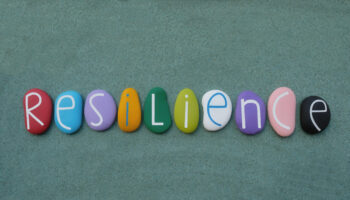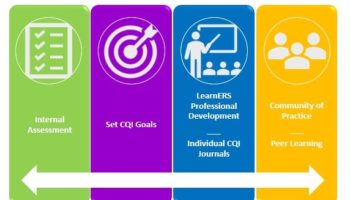Ancient proverb: A wise man builds a house by digging down deep and laying the foundation on rock. When a flood came, the torrent struck that house but could not shake it, because it was well built. One who is unwise builds a house on the ground without a foundation. The moment the torrent struck that house, it collapsed and its destruction was complete. This proverb reminds us that there is a distinct difference between merely surviving the changes around us and having the ability of thriving through them and growing because of them. The game of Jenga can help make an illustration to this point for quality improvements in early care and education settings.
Think about how Jenga looks at the beginning of the process. Let’s liken it to an ECE facility built on a sturdy foundation. All the quality elements are in place. Each block is a necessary and good component of quality. Health and safety, helpful and nurturing interactions with others, opportunities to learn from hands on experiences are all included in the structure. And the builder of this structure recognizes that that each piece relies on the strength of the other. Each piece needs to lean on the other to gain strength and stability.
What about the program that says, “What if we cannot do everything that promotes a good quality environment?” Are we not building a sturdy house? Are we going to get washed away in the current? The answer is, NO! If you are familiar with the game of Jenga, you know that choices can be made about what is taken away that will not make the structure fall. Perhaps you do not have a safe outdoor place for the children to play or your program is not accessible for persons with special needs. Strategically, things must be weighed out and calculated to make sure your structure does not collapse. From the look of the picture (above) you can see that a structure is still sound because thoughtful decisions were made about what could be changed. Choices about which blocks to remove must be carefully weighed and strategically chosen.
This Jenga picture can be the result of two things:
- The quality was unsteady from the beginning. Building a strong structure, “house of quality” from the beginning happens when one first becomes fully aware of the changes happening in the early childhood education field. Once familiarizing oneself with new and innovative ways to build stronger teachers begin to build, creating blueprints (make a plan) and then building without taking any shortcuts that would compromise the quality of the finished product.
- Too many quality elements were taken out. To build a healthy structure, it is important to know and understand what quality ECE entails and also to understand how one system builds upon and relies on another. For example, when children are in a clean and healthy environment they are more capable of learning and socializing well with others. An unhealthy or unsafe child is more likely to have negative interactions with others and be withdrawn from learning activities.
Life is filled with transitions—those we’re prepared for and those that are thrust upon us when we least expect it. No matter how these transitions arrive, there are ways to navigate transition that leave us healthier, happier, and finally, whole.
Top 10 ways to Thrive rather than just Survive the ERS process:
- Stay current: Teachers in all classrooms should be familiar with and review ERS books, PA Position Statements, and the All About the ERS books frequently. Change doesn’t happen overnight.
- Keep goals in focus: It is not just achieving a high score but improving the lives and educational experiences of the children every day. Quality actions, processes and practices are implemented every day-not just when the assessor arrives.
- Don’t take shortcuts: Real lasting change requires hard work and time. Shortcuts lead to short changing yourself. They fall apart quickly. You cannot build a house without a firm foundation.
- Don’t be afraid to ask for help: Although someone can survive alone, thriving takes a network. Even the best builder needs an electrician, a plumber, an architect, etc. Reach out to others as well. Recognize that everyone in these quality initiatives is committed to your success.
- The road to quality will present challenges: When building the foundation of a house, first you dig into the mud. One who just wants to survive will build despite the mud. One who thrives will remove the wet mud first. Be honest with the “current state of things” and be willing to clean things up a little.
- Each person at the facility needs to accept responsibility for a part of quality and see how their part fits into the whole. A house with a good exterior will not sell without good interior systems. The electric and plumbing must be in good shape, as well. If the inspection says that the internal systems are not strong, someone can take a cursory look at the exterior not see the whole picture. When there are large aspects of quality missing, the children are impacted.
- Thriving requires perseverance: Even a well-built house will not withstand a storm without regular cleaning, maintenance, and occasional renovations.
- See setbacks as opportunities for learning: Some things may not work as planned the first time they are tried. In building a house, on certain days it will rain and the structure will have to dry out before more is built. The builders do not abandon the idea of building the house despite the rain delay. Lessons are learned from what didn’t work, as well as what did work. Be patient as you build quality… it takes time.
- Be alert and self-reflecting: Surviving is doing things the same way year after year… lack of attention sets in and often quality decreases slowly without someone noticing it. Thriving is taking ownership, being creative, being innovative and always assessing where you are and where you are going.
- Enjoy and celebrate: When a program is thriving, goals are met and new goals are set, that is when you see true growth. A frame for a house is built on a foundation, the plumbing and electric are added, walls go up, then siding and a roof. Year after year the family may make plans for additions…but at each step they have celebrated. They took pictures after the basement had been dug. They enjoyed each stage of building their quality structure. They celebrate. Reward your teachers as your “house of quality” is built. After each goal you’ve established has been firmly reached…CELEBRATE!!!
For more information, please visit the Environment Rating Scales Institute website:
https://www.ersi.info/




